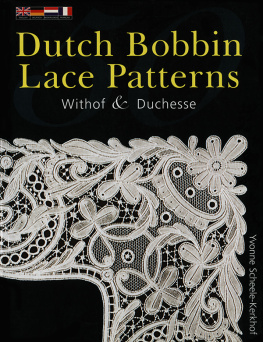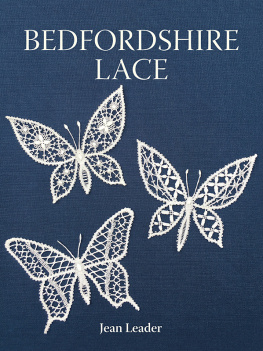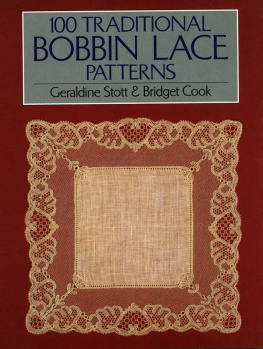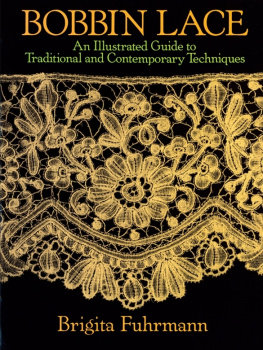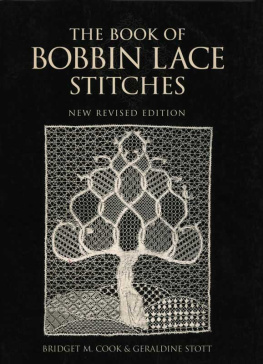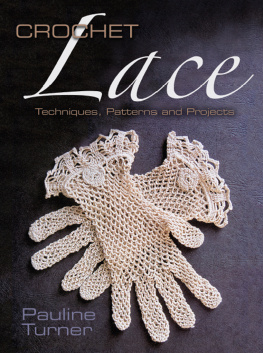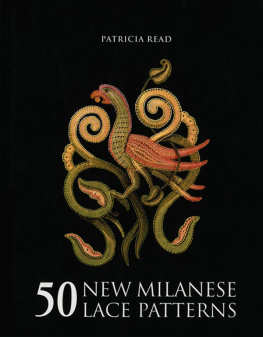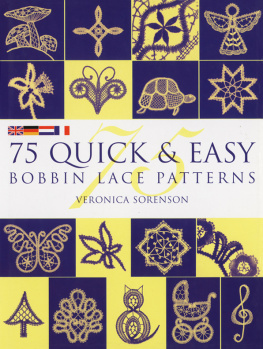About Batsford
Founded in 1843, Batsford is an imprint with an illustrious heritage that has built a tradition of excellence over the last 168 years. Batsford has developed an enviable reputation in the areas of fashion and design, embroidery and textiles, chess, heritage, horticulture and architecture.
50 Dutch Bobbin Lace Patterns
Withof and Duchesse
Yvonne Scheele-Kerkhof

Acknowledgements
I have received much help from many friends to whom I now gratefully express my thanks. A special thank you must go to my husband for his invaluable good sense and loyal support; Sister Judith for her enthusiasm and encouragement; Korrie Moser, Brbel Krting and Frances Brannon for their valuable comments on the manuscript.
A special thank-you is due to the friends and fellow lacemakers whose names appear by the patterns they have worked.
Danksagung
Allen die zur Entstehung dieses Buches beigetragen haben, sei an dieser Stelle herzlich gedankt. Mein besonderer Dank gilt meinen Mann. Fr Hinweise und Anregungen bin ich Schwester Judith in besonderen Masse zu Dank verpflichtet. Fr ihr wertvolles Kommentar zu dem Manuskript, bedanke ich mich bei Korrie Moser, Brbel Krting und Frances Brannon. Meinen Dank auch den Klpplerinnen die die im Buch erwhnten Muster ausgearbeitet haben.
Dankwoord
Ik wil al diegenen bedanken die mij geholpen hebben bij het samenstellen van dit boek. Een aantal van hen wil ik graag noemen: mijn man die me, waar nodig, helpt; Zr. Judith voor haar enthousiasme en aanmoediging; Korrie Moser, Brbel Krting en Frances Brannon voor hun waardevolle bijdragen aan het manuscript, en een aantal kantklosvriendinnen voor het uitwerken van enkele patronen. Hun namen staan vermeld bij de door hen gekloste patronen.
Remerciements
De nombreux amis mont beaucoup aid et je les remercie vivement. Un grand merci mon mari pour son bon sens et son aide; Soeur Judith pour son enthousiasme et ses encouragements; Korrie Moser, Brbel Krting et Frances Brannon pour leurs commentaires concernant le manuscrit.
Je remercie tout spcialement les amies et dentellires dont les noms figurent cot des modles quelles ont excuts.
First published 1997
Yvonne Scheele-Kerkhof 1997
First published in paperback 2001
The moral rights of author have been asserted.
All rights reserved. No part of this publication may be reproduced, stored in a retrieval system or transmitted in any form or by any means, electronic, mechanical, photocopying, recording or otherwise, without the prior permission of the copyright holder.
eISBN 9781849942393
Published in the United Kingdom as eBook in 2015 by
Batsford
1 Gower Street
London WC1E 6HD
An imprint of Pavilion Books Company Ltd
CONTENTS
INHALT
INHOUD
CONTENU

Introduction
A few years after the book Withof Lace was published, it became clear that a new book would be necessary to demonstrate the most recent advances in this modern lace. New elements have been added, and some techniques have been somewhat altered, in the lacemakers continuing search for ever more beautiful results.
As Withof lace has developed from Duchesse lace, its story begins in the mid-nineteenth century in Belgium. In 1850 the name Duchesse was given to a particular style of Brussels lace in honour of the Duchess Marie Henriette of Brabant, the wife of Leopold II of Belgium, who took a great personal interest in its production. The characteristics are: assortments of flowers; clover leaves; scrolls; circles, and raised veins, all arranged into a beautiful pattern and joined by a ground filling.
The Koninklijke Kantwerkschool in Sluis in the south-west Netherlands began producing Duchesse lace and, as the school developed its own techniques and variations, its lace was recognized over time as a separate style, becoming known as Sluis-Duchesse lace. Sadly the school closed in 1935.
As well as Withof lace, I had originally planned to include Sluis-Duchesse, but since I have slightly changed the techniques and style it cannot be truly called Sluis Duchesse. However, it must correctly be called Duchesse, since those characteristics are still recognizably present. Both laces are classed as Dutch.
Throughout the book I have tried to demonstrate the similarities and the differences in the laces by showing them side by side.
The first book on Withof Duchesse was published in 1988. Sister Judith, who was the initiator, designer and creative force behind this lace, chose the name Withof Duchesse: Withof after the convent where she lives, and Duchesse to describe the basic type of lace from which she developed her style. As in Duchesse, the motifs of Withof-Duchesse consisted of flowers, clover leaves and so on, but the working was different and included rolled edges which gave not only a beautiful finish to each motif, but also a three-dimensional effect to the overall work.
Today, one can no longer speak of Withof Duchesse since the typical characteristics of Duchesse have disappeared, and a recognizable style of Withof lace has emerged. Now the patterns are more stylized, one motif smoothly follows another, giving a lovely flowing line to the design as a whole. To accentuate these lines, Withof is worked mainly in cloth stitch, which is a perfect background to show off the beautiful structure of the design, but care must be taken that the lace does not appear too heavy. To avoid any heaviness, half stitch may be used here and there, and holes or other decorations may be introduced.
In earlier times, when the demand for lace was at its height in the fashion world, patterns were often designed by specialized artists. Unfortunately this is no longer the case, so today if one requires an exclusive design, one must create it oneself.
Remembering this old custom of commissioning artists to design special lace patterns, I turned to Sister Judith as the initiator of Withof when I began my book. Her life centres around lace, and her love for it is reflected in the number of patterns she has designed over the years, as well as the adaptations and changes she continues to make in her search for perfection.
I feel very honoured and grateful that Sister Judith was willing to design a considerable number of patterns especially for this book.
I have tried to show as many uses for lace as possible on clothes, in the home and as a decorative object. Personally, I would like to see lace worn as part of everyday fashion, which is why I have chosen to suggest the use of colours, as well as the usual white and cream.
All the colours used are pastel shades, and in many cases the thread has been dyed to match the colour of the fabric which the lace will ornament. Pastel shades were chosen, along with white and cream, as the only colours suitable for use in Withof or Duchesse lace, since all fine detail would be lost in black or darker colours.
In the book, 50 patterns have been either partially or completely worked. The diagrams and text show how motifs in both Withof and Duchesse can be moved and worked into other patterns, as I want to show clearly that by changing a pattern only slightly, for example by taking away one element, or putting in another motif, it is easy to create many personal patterns.
I hope that all readers will look at these patterns with different eyes and see how many possibilities there are for creating their own individual, exclusive patterns.
Next page
